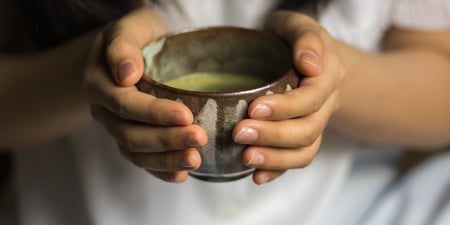
1. A Longer Exhale
This is such an easy one to slip into a busy day. Driving the car, waiting in a queue, trying to go to sleep - you name it, you can do this exercise.
Here’s what to do:
- Breathe in and count to 4.
- Breathe out and count to 6.
- Do this at least 5 times (or longer if you can).
- Really pay attention to your breathing. Notice your chest rise as you breathe in, and fall as you breathe out.
Why does this make us feel more relaxed? When we prolong our exhale, our blood flow slows down. This activates the parasympathetic nervous system, which aids relaxation.

2. Tibetan Nine Round Breathing Exercise
This is surprisingly effective. It’s quite active so it is perfect for a busy mind when more subtle meditative exercises feel too hard.
It’s also a great one for a mini-break at work because it’s only 9 breaths. No matter how busy we are, we can all stop and be present for 9 breaths.
First 3 breaths: Breathe in the right nostril, breathe out of the left nostril
With your index finger, block your left nostril while you breathe into your right nostril. Breathe in slowly and steadily, pause for a moment, then block the right nostril and breathe out through the left nostril.
Do this 3 times. Keep the in and out breaths slow and steady, and be aware of the sensations in the nostrils as you breathe. Put all your focus and awareness on your breath. Be with the breath.
Middle 3 breaths - Breathe in the left nostril, breathe out of the right nostril
Now do the reverse - block your right nostril and breathe in through the left nostril. Pause, then block your left nostril and breathe out through the right nostril.
Do this 3 times, slowly and steadily, staying with the breath.
Last 3 breaths - Breathe through both nostrils
Place your hands in your lap and breathe in through both nostrils, gently and evenly. Notice the different sensation of breathing through both nostrils.
Pause, and then exhale through both nostrils, keeping your attention on the felt sensation of breathing.
I give thanks to Venerable Sangye Khadro from FPMT for teaching this technique.
3. Breathe With A Tree
We often do this when guiding Forest Therapy walks. It’s ideally done outside standing in front of a tree, but it can be done inside with a pot plant.
Here’s what to do:
- Find a tree and stand in front of it. You may like to put your hands on its trunk, or if it’s a pot plant, place your hands on its leaves.
- Really notice the tree. Take it in with all your senses - what can you see, smell, touch and hear?
- Close (or half close) your eyes, notice your breathing, and then reflect on what is happening between you and your tree as you both breathe.
- On your in-breath, know that you’re breathing in oxygen that your tree released through photosynthesis (the process of converting sunlight into glucose to keep itself alive).
- On your out-breath, know that you are breathing out carbon dioxide, a key ingredient that your tree needs when photosynthesising sunlight.
- Stay with this reflection, as you breathe in and out. Breathe with your tree. I like to shorten it to ‘Breathing in - you give me oxygen. Breathing out - I give you carbon dioxide.’
- Really feel this - not as an intellectual exercise, but as a lived experience. With each in-breath, your tree is producing oxygen, just as you are breathing it in. You need oxygen to live. With each out-breath, your tree is absorbing carbon dioxide, just as you are breathing it out. It needs carbon dioxide to live.

This is so simple, but quite profound. Even just five minutes of breathing with a tree will make you more relaxed and grateful.
Being aware of these larger processes at play is humbling. No trees, no oxygen for our breath, no life. It can give a sense of perspective and of being part of something bigger.
While we depend on trees for our breath, we also offer them something of value when we breathe out. It’s an interdependent relationship.
Happy breathing! May it relax and nourish you.
And remember - your breath is always here to tap into when you need it.
Disclaimer: This Content has been developed from our generous global community and is intended for informational purposes only. This Content is not, nor is it intended to be, a substitute for professional medical advice, diagnosis, or treatment and should never be relied upon. Further, the personal views and experiences published are expressly those of the author, and do not represent the views or endorsement of SoulAdvisor through the act of publication on our site.















